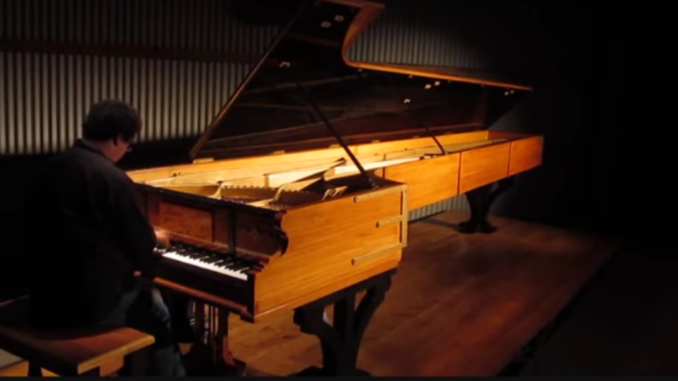
Unless you’re a musician, it may never have crossed your mind to wonder why grand pianos were so big. (I had never wondered until just a few minutes ago, but then, I am not a musician.) It has to do with physics. (Hah, I just worked science into this story – who’s surprised?) You’ve no doubt heard this explanation multiple times before, but bear with me for the sake of context. When piano keys are played, hammers inside the instrument strike piano wires, causing the wires to vibrate. The vibrating wires induce waves in the air. The waves travel across the room to your ear drums and voilà, you hear piano music.
That’s all well and good, you say, and yes you’ve heard it all before but what point am I trying to make? Grand pianos are larger than an upright piano built for a small room such as a parlor (homes had parlors back in the glory days of the piano). The wires in an upright piano are shorter than the wires in a concert grand piano or even a baby grand. Yet all pianos regardless of size produce the same notes. Why? Wouldn’t longer versus shorter wires change the pitch? The secret is in the wave. A piano wire vibrating in the key of C, for example, has a wavelength, and as long as the wire is an exact multiple of the length of the wave (technically, the half-length of the wave but I’m trying to keep this simple) it will produce the desired pitch (the frequency of the sound). This is an extremely simplified explanation, of course. In simplified summary, the middle C string on a concert grand piano, though longer than the same string on an upright piano, is a multiple of the length of string on the smaller piano. I’ve made that clear as mud, I’m sure.
The advantages of bigger pianos then are that they are louder and offer greater projection in a large room such as a concert hall. The tone is also deeper, richer, and more resonant. Which brings us to the Alexander Piano.
About fifteen years ago, fourteen-year-old Adrian Alexander Mann of New Zealand was learning to play piano and discovered he really liked the sound of a long bass string. The longer, the better, and through experimentation in his backyard, he found the perfect length of wire that produced the perfect bass pitch to please his ear. With the unbridled enthusiasm of a teenager, he decided he must build a piano that incorporated that length of wire. He had previously rebuilt an old piano, so he had some experience to start with. No one told him it wasn’t possible for a teenager to build the world’s longest piano, and his nieghbor let him use her garage and gave him some wood to get started. Later, when the project no longer fit in the garage, a friend’s father let Adrian move his project into their farm tractor shed, which was quite a bit larger. His blog goes into much more detail about the process.
Adrian’s creation is 5.7 meters (18 feet, 9 inches) which is more than twice as long as a concert hall grand piano. It sounds great too. These three videos demonstrate the range of the instrument. I like the last one best, myself, though you can see the piano in more detail in the first video.
“Fur Elise on World’s Longest Piano” (2:10):
“Rachmaninoff Prelude in G-minor, Op. 23, No. 5 – Thomas Nikora, Alexander Piano – Adrian Mann” (5:24):
“Gareth Davies” (3:56):
Question Of The Night: What rare or unusual instrument tickles your fancy?
